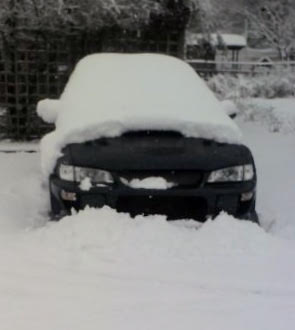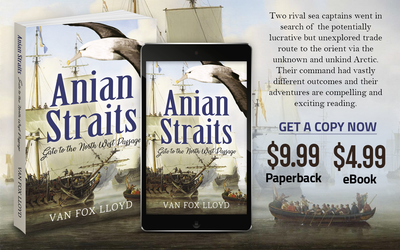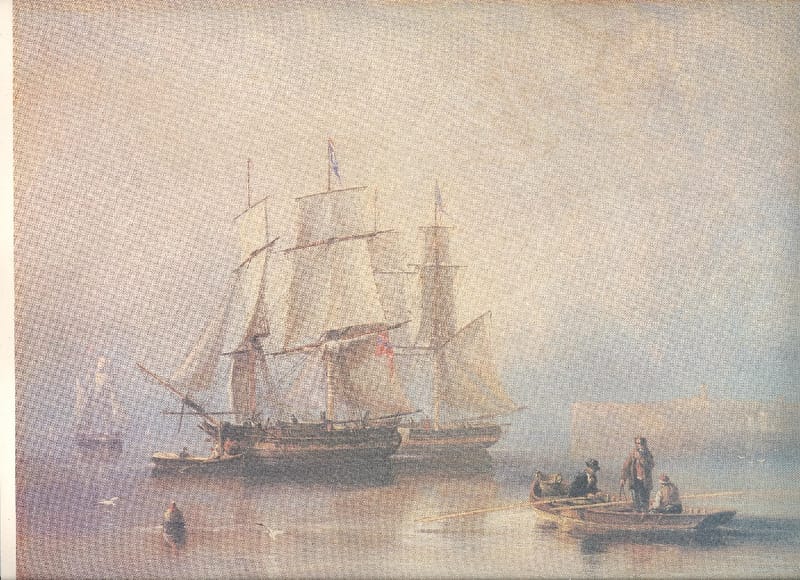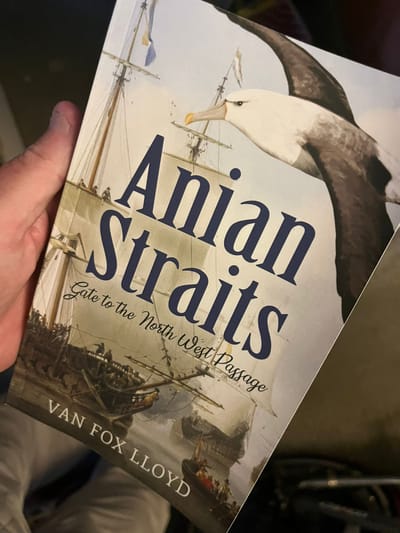
Summary of the journals
On May 2nd 1631 Captain Tom James hosts a party on board his ship, The Henrietta Maria, moored in the Severn Channel, for his benefactors, the Bristol Merchant Adventurers. The Rev Tom Palmer preaches a sermon to the crew and they sail from Bristol the following day.
Captain Luke Fox in his ship, The Charles, follows with less ceremony from Deptford on 5th May 1631, discharging her ordinance of 7 guns when approaching the Royal Court at Greenwich. At Buchan Ness, near Aberdeen lighthouse in Scotland, sharp winds snap the rotten main yard mast and they have run out of money to buy fresh provisions. They see a basking whale and a drifting tree, but the log is no use, so the carpenter fashions repairs. They sail on amongst shoals of killer whales and dodge large and small icebergs, one shaped like a church and steeple. Luke concentrates on his navigation, using an azimuth compass and almucantar staff and notices a fierce magnetic reaction at Cape Farewell. Unfortunately, his Master is becoming disagreeable and argumentative. He disputes the rigging preference and nautical findings.
Meanwhile, a month from departure, Henrietta Maria reaches Greenland in freezing conditions and is struck by icebergs in a storm. The poles used to stave off ice all break and the shallop is smashed, though they try to rebuild it. The crew take in the sails and pump out water. At Cape Farewell, the long boat, being towed, breaks away and during its rescue two men are injured. Struggling through ice, fog and walruses, the compass becomes inactive and Henrietta Maria is caught up in turbulent currents. Waves dashing against an ice bank make a hideous and frightening noise. A violent storm whips up and causes considerable damage to the ship, shrouds and cables. They navigate rocks in the shallop, trying to recover lost parts.
Captain Tom goes onshore ahead at Resolution Island. He builds a cross and great stone beacon at its highest point and names the place ‘The Harbour of God’s Providence,’ but the next day their ship is endangered by an enormous piece of ice half-mast high,. Tom goes onshore again to observe their position from a hill and returns in alarm after witnessing the berg break into four vast pieces with an appalling noise. Fearing the worst, Tom is relieved to find his ship safe. He sends the boat to a cove he has found, but they have a difficult journey and return, They sail the ship there instead and make fast on rocks before exploring the land, finding only frozen ponds and debris from savages and foxes. From the hilltops some see Sir Thomas Button’s Islands on the south side, others unsuccessfully try fishing.
On 23rd June, The Charles reaches Cape Resolution and smoke from Tom's camp fires is noticed. Knowing that The Henrietta Maria is in harbour, Luke sounds his cherished foghorn in salute. The Charles gets stuck in ice and damages her anchor. The Master shoots seabirds for stew from the cockboat, but the crew become peevish when their request for an increased allowance is refused. The Henrietta Maria’s crew are on rations and two get sick. At Mansell Island they go onshore and a kill a bird where there are freshwater ponds but no vegetation. Sailing west, they get stuck in ice and inspect the ship, only to find its damage irreparable. After a week in thick fog they venture onto the ice and toast His Majesty to cheer themselves up. Fuel for cabin fires is rationed and they have no luck fishing. In a fierce gale they strike rocks inflicting further damage and two days later they break a cable and lose an anchor.
The Charles is having a better time of it! Luke makes observations on the peculiar nature of different types of ice and records these in his log. On 25th June he sees a rainbow and imagines it an omen. The carpenter repairs slight damage to the rudder and crawfish are seen in the sand. All marvel at luminous protozoa slime in the sea. Luke draws up rules for shore exploration and observation of the flood tides. He advises wariness of natives and expresses worry about danger from collision with melting ice blocks during faulty watches. His disloyal Master and Mate grumble behind his back. They are East India men and his friend the mathematician John Briggs had warned against employing them, but he has had no choice. Exasperated by their discontented and insolent behaviour, he fears mutiny.
In mid-July a weather gall (cloud halo) predicts storms and the Master continues to hinder Luke by arguing with his instructions. Taking advantage of the Captain’s nap to steer his own course, he gives disheartening speeches of contempt to the crew. Near Salisbury Island, on 12th July. The Charles breaks her cutwater (at the prow) and the carpenter takes 7 hours to mend it, while Master mocks and blames the Captain. His own early interference with Fox’s list of requirements has resulted in an omission of oars amongst other essentials, which exacerbates the argument between them.
A creature with a 6’ black horn is thrown on deck from a shoal of 20. They call it a sea unicorn and Luke quaintly thinks it and the mountains are responsible for needle shake in the compass, although this is caused by electrical disturbance. He takes the boat out and finds seals. A polar bear is spotted on the ice where The Charles is moored, so their dogs are sent to chase him, though he dives away. The Master pursues and kills it with a lance, making 12 gallons of oil from it. They enjoy boiled and roasted meat under a sky of exhilarating Northern Lights, but at full moon their compass loses power. 300lbs of bread are soaked from a leak in the store. They see leaping fish amongst islands, one thought to be a sepulchre, which they explore, exploiting the graves of some 500 four foot tall natives for firewood and artefacts. They find whale fins and oil, copper darts, knives and needles and take souvenirs.
Sailing at Baker Foreland they see graves and pyramids and a white quartz beach at Marble Island, naming the area Sir Thomas Roe Welcome. Both captains are generating names to mark their exploration. The Charles' crew bring aboard two swans and a sand-hill whooping crane, but within days the unfortunate crane breaks its legs and dies. On land, dogs chase a stag cutting their feet on the terrain. Pursued by the quarter master with no weapon to kill it, the man is moved by its tears. A pod of 40 whales is seen at Hudson’s Bay where The Henrietta will spend the winter. There are sea pigeons and walruses they call sea-horses, but attempting to lance them is unsuccessful, due to the thickness of their blubber.
Towards the end of July Luke goes ashore for the first time and captures a live fox at Hope’s Check where he has been picking scurvy grass. This will be juiced and served for health in morning pints of beer. He sees a walrus in a waterfall and in hot daisy grassland there are deer, elks. geese and partridges. He comes across the relics of a Canadian birch canoe and finds carved toys in graves, but is sorely pestered by midges and mosquitoes. The Charles' company see cliffs at Churchill River where The Henrietta Maria went aground and she is now headed for the muddy waters of the estuary they have named the New Severn River. In August there is a tidal bore at Port Nelson and Luke anchors here to carry out ship repairs and assemble the pinnace, which has been stored in pieces. They clean guns, gather fresh water and hunt venison, observing Beluga white whales and porpoises in the rain.
At Seal Island they find a man’s footprint. There is evidence of camps but no natives are seen. They gather wild strawberries and gooseberries, hunt a stag which escapes. Under a sky ribboned with vivid colours, the carpenter fells five trees chosen by the Master for a replacement mast, but all are rotten. They kill a polar bear and discover more artefacts, mostly guns and ammunition. Luke finds half of a board bearing Captain Button’s Kings Arms with an inscription on it. He names this place New Yorkshire, but later concedes the title of New Wales, chosen by Tom.
Near the ship, three deer are swimming in the sea five miles from land and these are killed by the Master from the pinnace. Luke thinks of his wife and what she would be doing. He dozes on his watch to be later alert and observe the Master’s turn. He sees the cook giving out cans of beer against orders and questions the ship’s boy, overheard by the Master who complains to the crew. The boatswain confronts the boy and calls him a long-tongued rascal. In heavy rain the Master defies orders to pull up anchor and sends the men to dinner instead, which causes conflict and an argument with Urin, the Mate. Seeking solitude and peace, Captain Fox goes out alone in the boat. He sees geese and sea pigeons flying above dangerous rocks and reflects on feeling homesick, praying for the quarrelling to stop.
On 20th August sighting the coast, Captain James and his crew toast Prince Charles with their best liquor and name this area, The New Principality of South Wales. About nine that night, fearing they have lost the anchor and heaving in the cable, a sudden hitch in choppy seas throws the men from the capstan. In the dark a small rope had become entangled in the cable and around the master's leg, which was sorely bruised before he could clear it. One mate was hurt in the head, another injured his arm. Their strongest man was sent sprawling after being hit in the chest with a crowbar, one, with his head beside the cable, only just escaped, while the rest of the crew were severely flung about and bruised. But the gunner's leg was between the capstan and the cable, which took off his foot, tore the flesh from his leg and crushed the bones, bruising his whole body badly. In all, eight men were hurt and tended by the surgeon, who by midnight performed further amputation on the gunner's ruined limb.
A week later, on 27th August, Tom sends the boat, well manned and armed, to high land with written instructions and told to return by sunset. When they don't appear, the company worries about some disaster or attack, especially since no answer is made to their shot or false fires (blue lights that burn for several minutes, usually used at sea as night signals). When fire is noticed ashore they imagine it has been made by triumphant savages with everybody lost! Eventually onboard again, they say a sandbank, uncovered by the tide, prevented their timely return and this excuse pacifies Tom. No natives have been sighted and a storm follows. They manage their sails, exchanging a pair of courses for a main course, but travel backwards up to 18 leagues, when they see a ship to leeward, about four leagues ahead. It is, of course, The Charles!
29th August is a very cold day with a high wind and The Henrietta is sighted by The Charles. Tom sends a shallop the following day to invite Luke, with his Master and Mate, to dinner and their encounter is described on pages 36/37 of Luke’s log and page 4 of Tom’s log. Luke learns that The Henrietta has been almost lost. twice! Tom has not explored beyond Seahorse Point and he intends to over-winter. Back at The Charles, the options ahead are discussed and Luke considers wintering, but concludes he is against it. After days of heavy frost, the Master and boatswain fall ill. A violent storm on 6th September soaks the coal.
Tom experiences similar and fears his ship will sink. He moves his coal and his boatswain falls ill, fainting several times and apparently at death’s door. The weather changes to fog. Some crew anchor to explore land in the long boat and Tom goes out himself, recording much driftwood but little vegetation. His men find nothing useful either, but are becoming argumentative and divided in their opinions. There follows another disaster when the ship is run aground navigating the rocky shores, which is blamed on the crew’s carelessness and conceit. “The first blow stroke me out of a dead sleep and I, running out of my cabin, thought no other at first but I had been wakened, when I saw our danger, to prepare myself for another world! After I had controlled a little passion in myself and had checked some bad counsel than was given me to revenge myself upon those who had committed this error, I ordered what should be done to get off these rocks and stones.” With trial, error and hard work manipulating the sails, first putting them aback then furling them away, they pump out water in the hold to locate any leaks and an angry Tom considers letting out the beer, but orders the crew to throw out the coal instead.
As the ship beats, he is further alarmed to see some damaged outer sheathing float by when they coil cable into the long boat and, alas, it breaks at the capstan under the strain of men heaving, losing the anchor. Another is quickly cast out and they prepare for evacuation by loading the long boat with the carpentry tools, a barrel of bread, a barrel of powder, six muskets with some match (slow burning rope used to fire matchlock guns) and a tinderbox, fish hooks and lines, pitch and okum and anything else thought suitable to prolong life. The panic has lasted five hours and the sea has remained calm, although after prayers of thankfulness that evening, the wind increases. With the ship at anchor, those in the boat explore the rocky coast a little, but claim they can go no further. Being thoroughly exhausted, all simply rest aboard.
More men have fallen sick on The Charles, leaving it shorthanded. Coming on deck, Luke grabs the helm in the nick of time and narrowly averts disaster. It is too deep to anchor. The sky is magically alight with vivid colour while the crew struggle with the sails. Then chain plates break on the foremast. The ship’s company fear ice will prevent them from going home. More quarrels develop about navigation and tacking, but Urin (the Mate) is compliant. They sail through smashed ice observing the tides and hopeful of finding the NW Passage here, as suggested by Button. Some seek fresh water in a cove populated by seamors. A mother tries to make her cub dive and then attacks the boat, only to be wounded by a lance.
Crew are still becoming sick, so Luke organises a party with pancakes and beer to lift spirits. He suspects the Master has been feigning sickness to burden him by avoiding his watch. Lightening and the flashing Aurora Borealis illuminate the sky. Damage occurs to the anchor and cable. The ship’s carpenter falls ill. The hold has been broken into with beer, aqua vita and sack stolen. The Master appoints four beef and sack days and Mate Urin frequently appears drunk. The cook is now sick and Luke steers for home in snow. To raise morale he increases the crew’s provision allowance. There is a violent storm. Arguments arise over the route and the ship is managed by a skeleton crew. The lazy, unpleasant Master stays in his cosy cabin and only gets up when they arrive on October 31st. All are safely home and the sick men ail recover.
The Henrietta Maria, however, continues her hapless adventure. The shallop towed at stern upends and breaks away. They explore in the long boat but misjudge the tide and get into difficulty, having to be hauled in. Perils and distress are described and converted to poetry by a sentimental and emotional Captain, who also leaves a letter at Charlton Island. Romantic poet Samuel Coleridge, two centuries later, borrows these ship- logs from Bristol library and discussing them with his friend and fellow poet, William Wordsworth, finds sufficient inspiration to write his most famous Rime, clearly drawn from these original ancient mariners’ extraordinary first hand accounts of their strange and dangerous voyages in the historical past.
Heavy snow and choppy weather create lofty waves and unearthly sounds. Tom moors the ship by an island and they collect firewood, but the increasingly fierce coldness makes the men sick and weak. The sails are useless clogged with ice so they thaw and fold them by the hearth. Led by the carpenter, a gang construct a wooden shelter on-land and use the mainsail to cover it. With a pair of greyhounds another group go on a deer hunt and rejoice in killing one. A scouting party travel about the island in deep snow but lose the gunner’s mate who falls through ice crossing a pond and drowns. At the end of October there is an eclipse of the moon and Tom takes readings with his advanced nautical equipment. Congealed ice at the shore means the men have to wade and carry each other to land provisions from the ship. They sink a well near the house, trap pied foxes hoping for a valuable black pelt and the carpenter builds a boat from boards. The dwelling is accidentally set alight by its own fire, so they set up a watch.
The amputee gunner dies in his cabin on-board at the end of November. Henrietta Maria is driven towards the shore to dock but veers towards dangerous rocks, eventually beaching in deep sand during a sudden storm. Tom calls a management meeting and shares his intentions. The carpenter is instructed to make a breach near the keel and a hole in the hold to sink her and the men must evacuate. He is the last to leave. All are miserable and disguised by frost and snow clinging to their faces. The account of their wintering is the most interesting part of Captain James’ journal (from pages 18-49) and it proved a gigantic mistake, being a time of great hardship, with all suffering from exhaustion and starvation. Tom's map of the region has little historical worth and they were absent from England three times as long as Luke in The Charles, yet achieved less geographical discovery. There were accidents, injury, misfortunes and deaths.
The aristocratic and affluent Captain Tom James was nevertheless applauded and welcomed home. He continued his successful naval career pursuing pirates, while Captain Luke Fox, for certain the greater hero, was unfairly denied promised payment and subsequently died in poverty.










